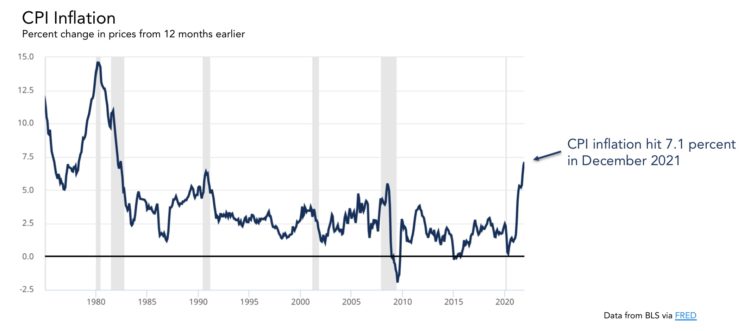

By Edward Farrell
The January 19 Retired Men’s Association speaker was Karen Dynan, Ph.D., a Professor of the Practice in the Harvard University Economics Department. Dr. Dynan chose as her topic for this webinar: “What’s Next for the U.S. Economy? Prospects for Growth, Jobs, and Inflation.” She indicated at the outset of her talk that she would be addressing the current status of the U.S. economy, key questions regarding the economy going forward, and the risks to continued economic recovery as the Covid-19 pandemic subsides.
With respect to our current economy, Dr. Dynan suggested that the current rate of recovery is in many ways better than might have been expected. She suggested that it usually takes up to a decade to recover from a severe economic decline such as the one we have recently experienced because of the pandemic, but in terms of GDP growth, we seem to be recovering more quickly. She suggested that economic fundamentals are strong, and indicated that since the beginning of the pandemic, household economic conditions have improved by 20-40%. This improvement is due, in large measure, to increased wages and government support. These conditions, in conjunction with increased savings, largely because of a slowdown in buying due to the pandemic, have enabled a spending power build up resulting in demand for goods in particular, but not yet so much for services. Pent up demand, as well as bottlenecks in the supply chain are key reasons for the supply shortages in many sectors, and rapid inflation has resulted. The unavailability of semiconductors, for instance, has driven the cost of used cars up 40% and new car costs up 12% since the beginning of the pandemic. Worker shortage has also impacted the economy and driven up inflation. There are currently 2.25 million fewer people employed than two years ago.
In discussing what the future holds, Dr. Dynan sees demand for goods staying strong and demand for services improving. The recent infusion of federal government cash to state and local governments, as well as excess household savings, will accelerate spending. Dr. Dynan suggests that there will be an easing of bottlenecks and other supply chain issues, but such easing may be impacted adversely if China “shuts down” to battle the virus. As (and if) the virus subsides, people will return to work, but overall employment might be impacted by childcare issues, fewer older people returning to work or continued immigration shortfall.
Dr. Dynan suggests inflation will end, but it will take time to reach the 2% Federal Reserve objective. How fast that goal will be achieved will depend on Fed policies, which current indications suggest will be less supportive than in recent years.
Dr. Dynan indicated there are risks to achieving “normalization.” Economic recovery may be stymied, for instance, if a new virus variant appears, if the markets are surprised by an unwelcome Fed policy change or if a black swan event occurs (e.g. global financial crisis, new pandemic, cyberattack, geopolitical disruption).
Dr. Dynan concluded her very informative presentation by responding to questions from members and guests. She suggested that a change in control of Congress resulting from November’s election would not likely impact the current path to economic recovery. She also indicated a decline in inflation from the current 7% to 2% is likely by sometime in 2023, and that unemployment will be at 3% by fall.
To stream Professor Dynan’s presentation, click here (https://vimeo.com/668199043).
The next RMA presentation, “Successfully Aging at Home and in Our Community,” by Steven Katz, will be on Wednesday, February 2 at 11 AM. Mr. Katz will discuss what it means to successfully age through the different stages of your older adult lifespan. What is successful aging? How do we adjust our environment to allow us to age safely and with a high quality of life at home and in our community? What are our different options and their costs? Given our individual circumstances, how do we decide what is right for us?
Steven Katz is the Chairman of the Commission on Aging for the Town of Greenwich and is co-spearheading Greenwich’s Age and Dementia Friendly certification initiative with the AARP, World Health Organization, and Dementia Friendly America. Steve is the Ambassador of the Aging 2.0 Greenwich Chapter. Mr. Katz is the President of Sterling Care, a certified home
health agency, a non-medical companion and homemaker agency, a certified geriatric care management practice and senior living placement service based in Greenwich, CT. Steve is also an adjunct professor of Health Care Policy and Management at the Columbia University School of Public Health.
Steve has an MPH from Columbia University, an LL.M. in Taxation from NYU School of Law, MBAs in Finance and Accounting and a JD from Fordham University, and a B.A. in Psychology from Brandeis University. He is a New York Certified Public Accountant and has been admitted to the Bars in NY and CT. Steve is a Care Manager Certified, a Certified Geriatric Care Manager, a Certified Dementia Practitioner, a Fellow of the American College of Healthcare Executives, and a Society for Human Resource Managers – Senior Certified Professional.
RMA speaker presentations are presented as a community service at no cost to in-person or Zoom attendees. The RMA urges all eligible individuals to consider becoming a member of our great organization, and thereby enjoy all the available fellowship, volunteer, and community service opportunities which the RMA offers to its members. For further information, contact Michael Ambrosino (mailto:brooklynoil@yahoo.com) or Peter Stern (mailto:pmstern@optonline.net).
To stream Steven Katz’s presentation at 11 AM on Wednesday, February 2nd, click here (https://bit.ly/30IBj21). This presentation will also be available on the local public access TV Channels, Verizon FIOS channel 24 and Optimum (Cablevision) channel 79.





